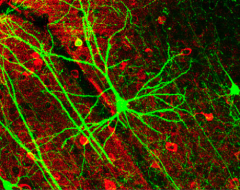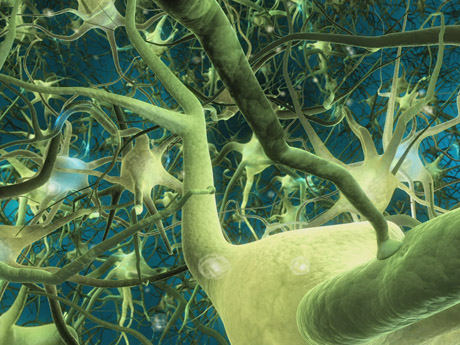PSYC 2: Biological Foundations -
Fall 2012 - Professor Claffey
Neuron
History:
10/26/12 - formatting updated
10/1/12 - original version
Background
Functional unit of nervous systemA cell specialized for the ___________________ and ___________________ of signals
____ billion in adult human brain (source)
Uses ____________________ and ______________________ systems to communicate
| In central nervous system |
In peripheral nervous
system |
|
| clusters of cell bodies |
||
| bundles of axons |
Cell basics
Nucleus & DNAMembrane
Organelles
Mitochondira
Energy metabolism: constant need for _____________ and _____________
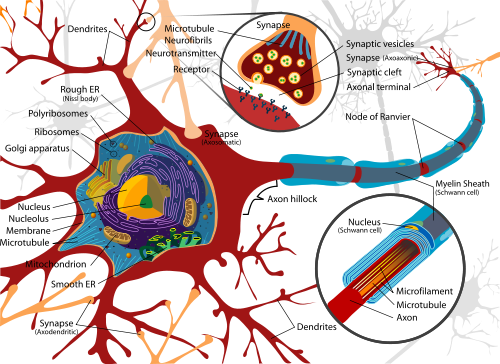
Source: http://en.wikipedia.org/wiki/Neuron#Anatomy_and_histology

Source: Pinel
Structures for communication
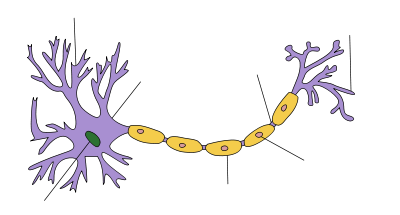
Source: http://en.wikipedia.org/wiki/Neuron
Types of neurons
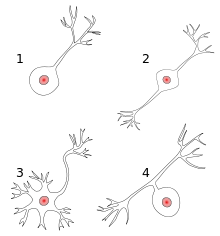
http://en.wikipedia.org/wiki/Neuron#Functional_classification
Glial Cells
Support cellsGenerally outnumber neurons (as much as 10:1 in some parts of the brain)
Oligodendrocytes
myelin extensions wrap around axons in central nervous system
provides myelin to multiple neurons
Schwann cells
provides myelin in peripheral nervous system
1 Schwann cell per axon
can aid in regeneration
Microglia
aid in recovery, part of inflammation process
Astrocytes
historically seen as "glue" or support cells
increasingly recognized for communication abilities
part of blood-brain-barrier and may regulate blood flow
recycle neurotransmitters
Resting Potential
Where is this going:The neuron is going to rapidly move ions across its membrane
It spends the energy in advance to setup for this action
Potential
Energy that is available to do workBall at top of slope, spring, laptop battery
Chemical gradients
Example of non-charged particles diffusing across barrier to reach equilibriumConcentration gradient - the "downhill" change in concentration
Electrical gradients
Ions - molecules that carry a negative or positive chargeElectrostatic pressure - the force pushing molecules down the gradient (space below is intentionally blank for drawing)
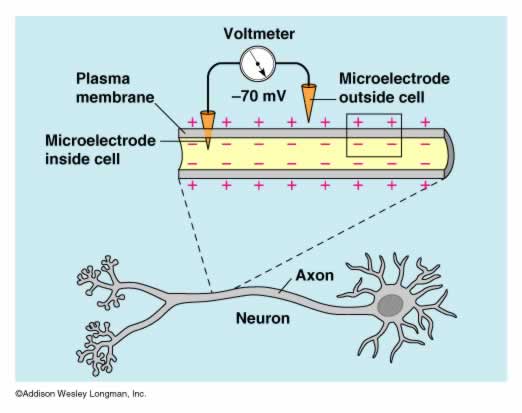
Source: http://www.anselm.edu/homepage/jpitocch/genbio/nervousnot.html
Sodium-Potassium Pump
A pump that moves ___________________ out and _______________ in by using __________________(The brain uses about 20% of your daily calories, this is a major component)

Source: http://hyperphysics.phy-astr.gsu.edu/hbase/biology/nakpump.html
Not really a pump, but just a _________________
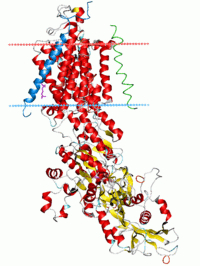
Source: http://en.wikipedia.org/wiki/Na%2B/K%2B-ATPase
Channels
Proteins embedded in the membrane that allow molecules to _____________ diffuse throughVoltage-gated channels - open and close in response to _________________________________
Ligand gated - open and close in response to _________________________________
Na+ channel - _________ at negative potentials, slower/faster to respond
K+ channels - _________ at negative potentials, slower/faster to respond
Neuron's Resting Potential
Typical resting potential is _______Sodium (Na+)
Potassium (K+)
Cloride (Cl-)
Organic anion (A-)
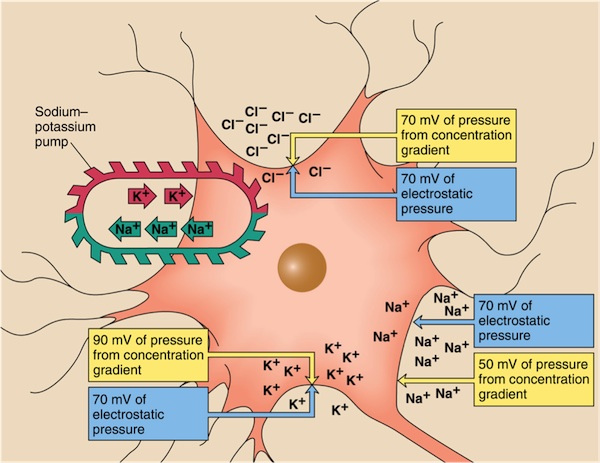
Source: http://academic.uprm.edu/~ephoebus/id81.htm
Action Potential
Where we are going:How does a signal get passed down the neuron (along the axon)
A sequence of events that disrupts the action potential
Post-synaptic potentials
Axon terminals release neurotransmittersThese neurotransmitters react with receptors on the next neuron
Can cause the neuron to depolarize or hyperpolarize
Polarization
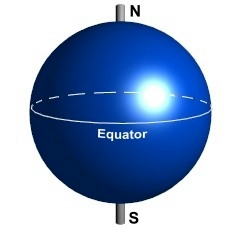
Source: http://www.polaris.iastate.edu/NorthStar/Unit1/activity1.htm
Depolarization
Hyperpolarization
Sub-threshold depolarization
Does NOT make membrane potential more positive than threshold (typically -65 mV)A little Na+ comes in, making the potential more positive
K+ is pushed out by the incoming Na+ and the NaK pump is still working, so returns to resting potential
Above-threshold depolarization
DOES make membrane potential more positive than threshold (typically -65 mV)As it depolarizes, more and more sodium channels open
Na+ starts coming in faster and faster, creating positive feedback
Full action potential occurs
Total number of ions flowing through membrane is relatively small, so concentrations do not change much
Stages
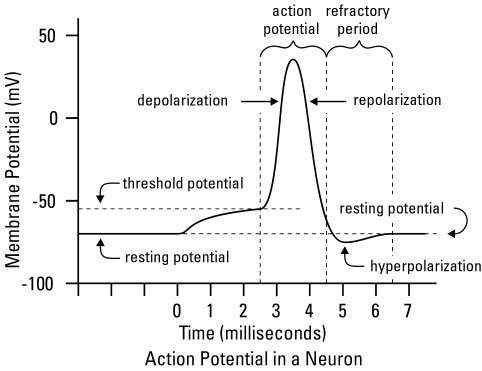
Source: http://www.dummies.com/how-to/content/understanding-the-transmission-of-nerve-impulses.html
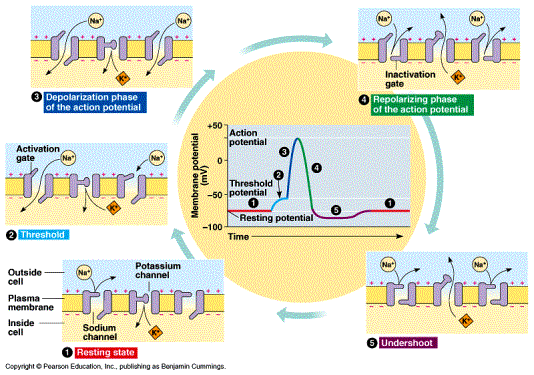
Source: http://www.msdellasantina.com/Files%20AP/Ch%2048%20Neurons%2006_files/slide0078_image046.gif
Depolarization / rising phase
becoming more positive as Na+ channels open
with all channels open, Na+ pushes potential up to +50 mV
Repolarization
at maximum positive voltage, Na+ channels close & no-longer voltage sensitive
K+ channels eventually fully open
K+ pushes out until voltage goes negative
Undershoot
With K+ fully open, potential goes more negative than resting
Once K+ go back to mostly-closed-but-leaky, returns to resting potential
Refractory Period
Immediately after firing, another depolarization will not trigger an action potential
absolute refractory period - no action potential possible
relative refractory period - action potential requires stronger depolarization
a few milliseconds long
Where in the neuron
Starts at axon hillock (typically)Travels down axon
Triggers events at axon terminals
Does not automatically pass into next neuron
Source: http://www.anselm.edu/homepage/jpitocch/genbio/nervousnot.html
Saltatory conduction
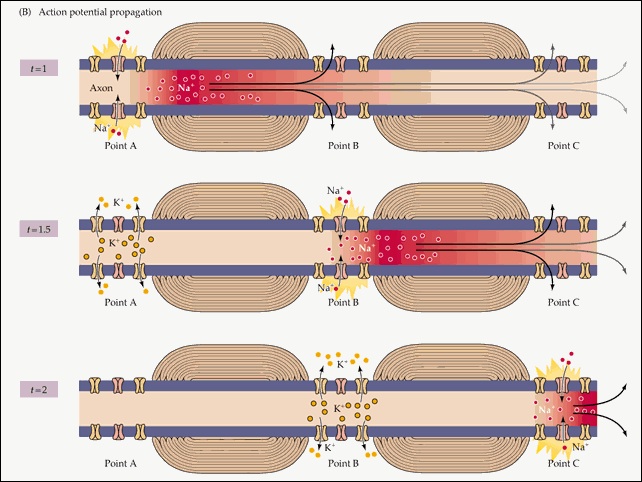
Source: http://psych.hanover.edu/classes/sensation/WebNotes/Class04-2010.html
Myelin covers most of neuron with a few gaps
Ions only exchange across membrane at these gaps
For reasons related to particle diffusion, this is faster than continuous conduction
Myelinated neurons (e.g. motor neurons) - 100 m/s
Unmyelinated neurons - 1 m/s
Principles
All-or-noneOne directional
Electrical
Fast
Active vs. Passive
Unanswered:
What starts the action potential? How does a neuron get depolarized?
Copyright 2012 - Michael Claffey
